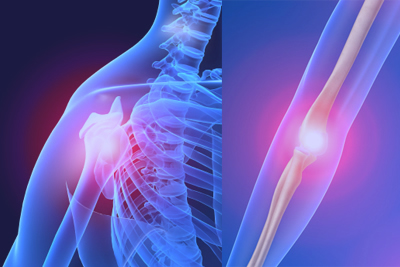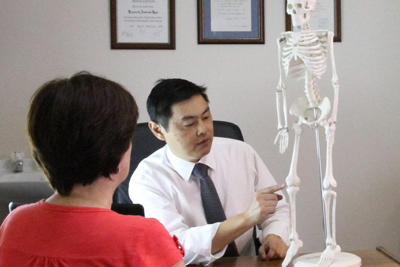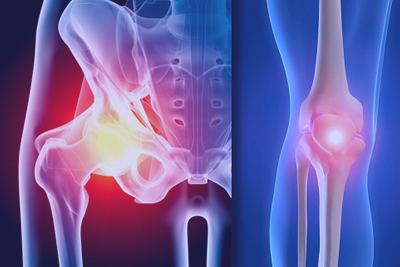Management in the Newborn
In DDH, the aim of your management is to secure a normal hip by skeletal maturity. The best chance of achieving this is to commence treatment in the newborn period.
The hip joint develops as a result of a delicate, genetically determined balance between the growth of the acetabulum and a well centred femoral head. The shape of the acetabulum develops in response to the spherical shape of the femoral head. The normal acetabulum is almost a hemisphere. Interstitial growth within the triradiate cartilage causes the acetabulum to expand its diameter. It grows in depth by interstitial growth in the acetabular cartilage and by appositional growth in the margins of the cartilage. At puberty, depth is further enhanced by development of at least 2 (often 3) secondary centres of ossification in the hyaline cartilage surrounding the acetabular cartilage. Normal acetabular growth is therefore dependent on a balance between the growth of the acetabular and tri-radiate cartilage.
This normal development of the acetabulum is disturbed if constant contact with the femoral head is lost. The acetabulum then assumes an oval and often globoid shape. Acetabular depth is more severely affected than the diameter. Buckley and associates ( JPO 1991) demonstrated by computerised tomography that acetabular deficiency varied according to the cause of hip dislocation. In CDH the acetabulum is deficient anteriorly and superiorly. Perhaps we should begin by defining hip dysplasia. On the surface this sounds simple. We know from post-mortem studies that the acetabulum covers the femoral head comprehensively at birth in a normal hip. Any inadequacy of cover should therefore be regarded as abnormal. The issue is complicated firstly by difficulties we have with imaging the neonatal hip which is largely cartilaginous. Plain X-rays image only the ossific portion of the acetabulum and for at least the first 3-6 months the femoral head is cartilaginous.
A number of radiological indices are used to assess acetabular shape and its relationship to the femoral head. The Acetabular index is frequently used for this purpose and it is notoriously unreliable and affected by positioning of the patient. Quite numerous studies have been done to determine the normal range in infancy. The figures given for normal hips range from 20 to 40 degrees averaging 30 degrees at birth and decreases to 20 degrees by the age of 2.
Ultrasonography is becoming increasingly popular in the assessment of early CDH. Its advantages include real time imaging of soft tissue and cartilage, no irradiation, no sedation and the investigation can be performed with a Pavlik Harness on. Two methods are used to assess reduction, progress and stability. The Graf method(1981) is a static examination measuring alpha and beta angles and based on coronal imaging of the hip. Harcke (1984) uses a dynamic stress method with axial and coronal images. Features of importance in assessing ultrasound include visualisation of a straight iliac wall, triradiate cartilage, the labrum should curve down, femoral head cover > 50%, graf criteria, Harcke dynamic stress.
In evaluating DDH in the newborn and infant period, the two main issues are hip instability and acetabular dysplasia. Acetabular dysplasia may occur with or without instability.
INSTABILITY
1)Dislocated hip:
a)Reducible
Clinical sign – asymmetrical hip abduction most reliable sign, though not always so.
Not all hips with full hip abduction were normal – 31% dysplastic hips had normal abduction – incl some dislocated: decreased abdn in only 70%. Other signs include shortening of thigh and a positive Ortolani sign.
When the diagnosis of CDH is made in the new-born, there is a 90-95% chance of achieving successful treatment with simple flexion / abduction splintage. The Pavlik Harness is a well accepted device to maintain hip flexion and abduction. Until 1946, CDH was managed by manipulative reduction and maintenance by casts or braces. However the rate of Avascular necrosis of the femoral head was high. This led Pavlik to develop a new concept of “functional treatment”. He believed by maintaining an infant’s hip in flexion, gentle abduction will occur, resulting in reduction of the hip. He emphasized the philosophy that the hip must have motion to achieve reduction and correction of acetabular dysplasia. The Harness (called Stirrups) are the tool, not the principle. Reduction is monitored with U/S at 2 weeks, then at 6weekly intervals until acetabular morphology is normal. X-Rays are taken at 6 months.
b)If hip not reducible The hip may relocate slowly in the harness over several weeks and worth trialling. However if the hip remains unstable in a brace, closed reduction and plaster spica is required. . I do not use preoperative traction in infants under 6 months. The reduction is documented with Arthrography intra operatively or with postoperative MRI. Arthrography is of great value not only in identifying obstructions to a reduction (hourglass constriction, inverted limbus, pulvinar and hypertrophic lig teres) but more importantly, to determine if the reduction is complete. The spica is changed at 6 weeks.
If closed reduction fails or non-concentric reduction is present or when the stable zone exceeds the safe zone (ie unstable), open reduction is required. In non-walking age children I use the Weinstein medial approach. This requires minimal dissection and results in minimal blood loss and also allows attention to the main obstacles to reduction. The risk of AVN is 6-20% but some of this is reversible and the outcome is generally satisfactory.
2)Dislocatable hip:
If diagnosed clinically these babies do not require ultrasound for confirmation. Ultrasound is used for monitoring. There are hips that want to stay in and hips that want to stay out. Dislocatable hips want to stay in. Therefore it is reasonable to wait 3 weeks before re-examination. If the hip is then still unstable treatment in a harness is required.
3)Dysplastic Hip:If the hip is stable but dysplastic on U/S, there is no urgency for treatment. I consider waiting 6 weeks and review with a progress ultrasound. If improvement is seen, continue to observe however if the hip is still dysplastic, treat in a harness. An Ultrasound is performed at 6 weeks followed by an xray at 6 months.
ACETABULAR DYSPLASIA
These hips are stable but U/S abnormal. There is confusion about what represents true dysplasia and which hips require treatment. Statistically hip dysplasia is present in 4% of newborns, whilst dislocations amounted to 0.1%
What are the outcomes for hip dysplasia detected at birth?
1)It may resolve spontaneously - this occurs in the majority of babies. The literature would suggest that at least 50% of ultrasonographic dysplasia with instability will resolve without treatment and that an even larger percentage (more than 75%) that are merely “dysplastic” but have no associated instability become normal within weeks.
2)It may remain dysplastic without frank dislocation. The acetabulum remains deformed and steep but the femur may or may not be subluxed.
3)It may remain dysplastic with subsequent dislocation. This may occur slowly over many years such as in Cerebral Palsy.
At the present time, there is insufficient data to allow confident use of U/S to develop guidelines for the early management of acetabular dysplasia. There is clearly a wide spectrum of dsyplasia and certainly a large number of radiologic and ultrasonographic “dysplasias” are merely a reflection of variation in skeletal maturity of the neonate. Such apparent dysplasias resolve without treatment. Clearly, the condition is overdiagnosed and over treated exposing the child to complications of treatment. Our difficulty is therefore identifying what constitutes significant dysplasia in early infancy and predicting which dysplastic hips will resolve spontaneously and which cases require treatment.





 Dr. Leonard kuo
Dr. Leonard kuo